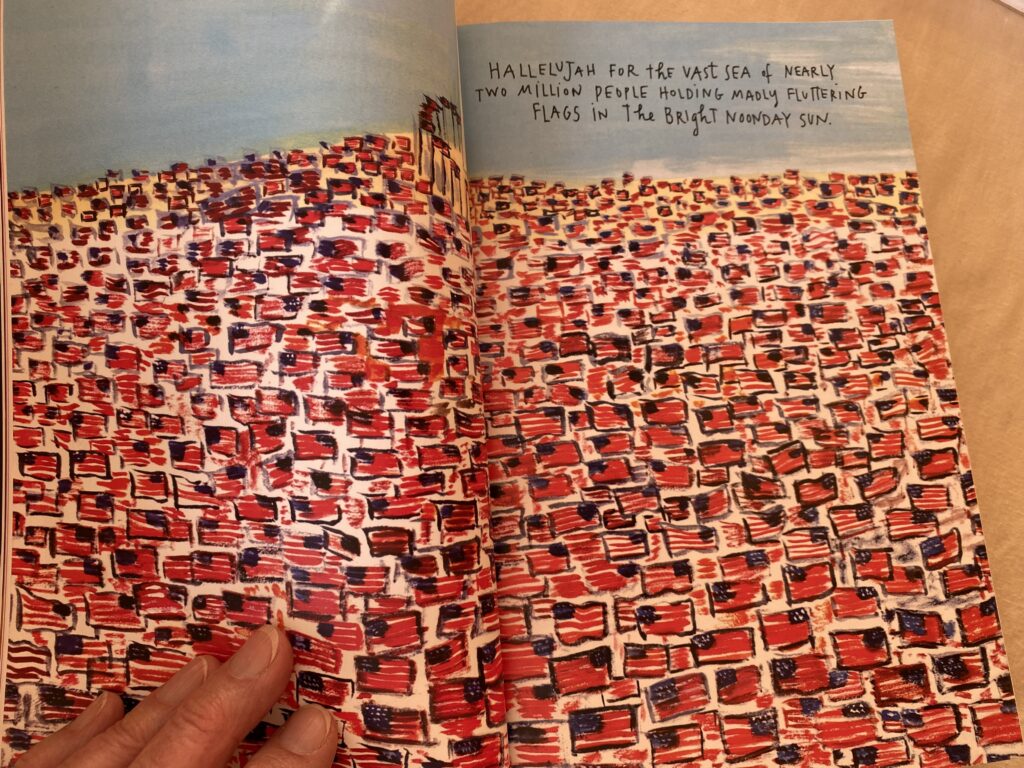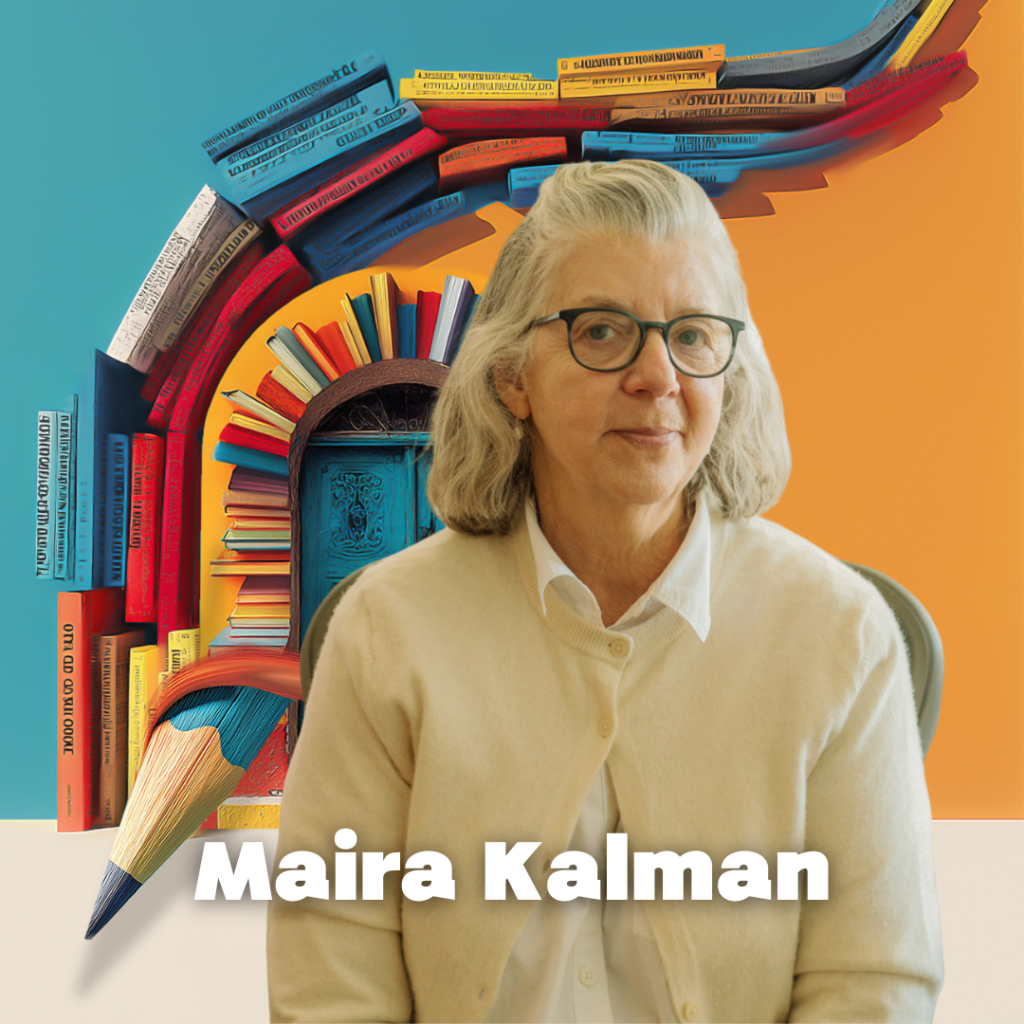My friend Kim loaned me a book last week, which I just finished reading last night. It’s a fat and heavy book – 471 pages of the finest quality paper – filled with whimsical, bright, childlike art and handwritten text, all by the award-winning author and illustrator Maira Kalman, titled AND THE PURSUIT OF HAPPINESS.

Published in 2010 by Penguin, this marvelous book follows one year – each chapter a succeeding month – from Barack Obama’s inauguration in January 2009. In that year Kalman travels the U.S. in search of proof of the hoped-for happiness Thomas Jefferson wrote of in the Declaration of Independence. And, like a child with stars in her eyes, she finds some of that happiness everywhere.
She begins her quest in Washington, D.C., of course, where, among other things, she gets to hold in her own hands the velvet Bible that Lincoln used for his inauguration and Obama used for his. Beneath her painting of this old Bible, her caption reads: “Abraham Lincoln. Maira. Barack Hussein Obama. Nice.”
And across a two-page spread of shoulder-to-shoulder small American flags at the inauguration she writes, “Hallelujah for the vast sea of nearly two million people holding madly fluttering flags in the bright noonday sun.” Such hope and optimism emerges from her on every page.

At the Lincoln Archive in Philadelphia, she’s captivated by Abe’s “magnetic appeal,” falls in love with this brilliant visionary, and feels crushed when she realizes he was only 56 years old when he died — “murdered,” as she writes, “while laughing at a silly British comedy.” At Gettysburg she reminds us of the ending of Abe’s greatest speech: “… government of the People, by the People, for the People, shall not Perish from this Earth.”
And she shares an embroidered sampler of Abe’s words (so important for us to heed today): “The occasion is piled high with difficulty. As our case is new, so we must think anew, and act anew. We must disenthrall ourselves, and then we shall save our country. – A. Lincoln 1862”

In Vermont, Kalman attends a small town political meeting, expecting “all kinds of characters venting their fury about perceived injustices,” but finds instead people who “speak their mind with grace and civility” and “listen with respect.”

She features some of the greatest women of American history, including the slave Sojourner Truth, who, as Kalman writes, “was sold to this man and then that man and then another man, and was finally freed. She fought for justice her entire life.”
At Thomas Jefferson’s home, Monticello, in Virginia, Kalman takes us inside: “You walk into the Palladian house that he designed and redesigned, with the triple sash windows that he invented, and you immediatley appreciate the breadth of his curiosity,” she writes. We learn he was only 33 when he wrote the Declaration of Independence. His rooms were covered in paintings. His study was filled with books. He wrote to his friend John Adams, “I cannot live without books.” But, Kalman admits, this “monumental man” also had “monumental flaws.” He was a slaveholder and the father of six children by his slave Sally Hemmings.
And on and on she goes, visiting famous and not-as-famous places and people throughout the country – observing, remarking, and recording in her one-of-a-kind charming sketches a time that now seems lost to history, a time that now feels sweetly naïve and too childlike to be true.
I came away from this book feeling not just deeply nostalgic but also sad. I had to remind myself that Maira Kalman – who came to the U.S. as an immigrant from Israel with her family in 1954 and settled in Riverdale, New York – published this book only 15 years ago.
So much has changed in such a short period of time, all of our heads are spinning. In just one year into his second administration Trump has made the country almost unrecognizable. “Pursuit of happiness?” Well over half of the U.S. population is miserable, thanks to him (his approval rating has just dipped to 42 percent, according to today’s New York Times), to say nothing of those all over the world who are suffering because of his dictatorial rulings. (One “small” example: his ending of USAID.) Jefferson and Lincoln, among all those other greats, must be roiling in their graves.
I’ll be attending Maira Kalman’s keynote address at the upcoming San Miguel Writers’ Conference in February, and I’m looking forward to hearing what she may have to say about all this. After reading her beautiful book, AND THE PURSUIT OF HAPPINESS, I feel as if she and I are old friends who’ve been experiencing the same whiplash.
~ ~ ~ ~ ~ ~ ~ ~ ~ ~ ~

Yes, Maira Kalman will be a keynote speaker at the 2026 San Miguel Writers’ Conference & Literary Festival, scheduled for February 11-15, 2026, alongside other prominent figures like Abraham Verghese and Emily St. John Mandel. Kalman’s presentation, titled “From Remorse to Joy – Women Holding Things in Conversation,” will be held on Thursday, February 12, from 2:00 -3:15 pm. Perhaps I’ll see you there?
For more about the conference lineup, please go to: https://sanmiguelwritersconference.org/#packages .
